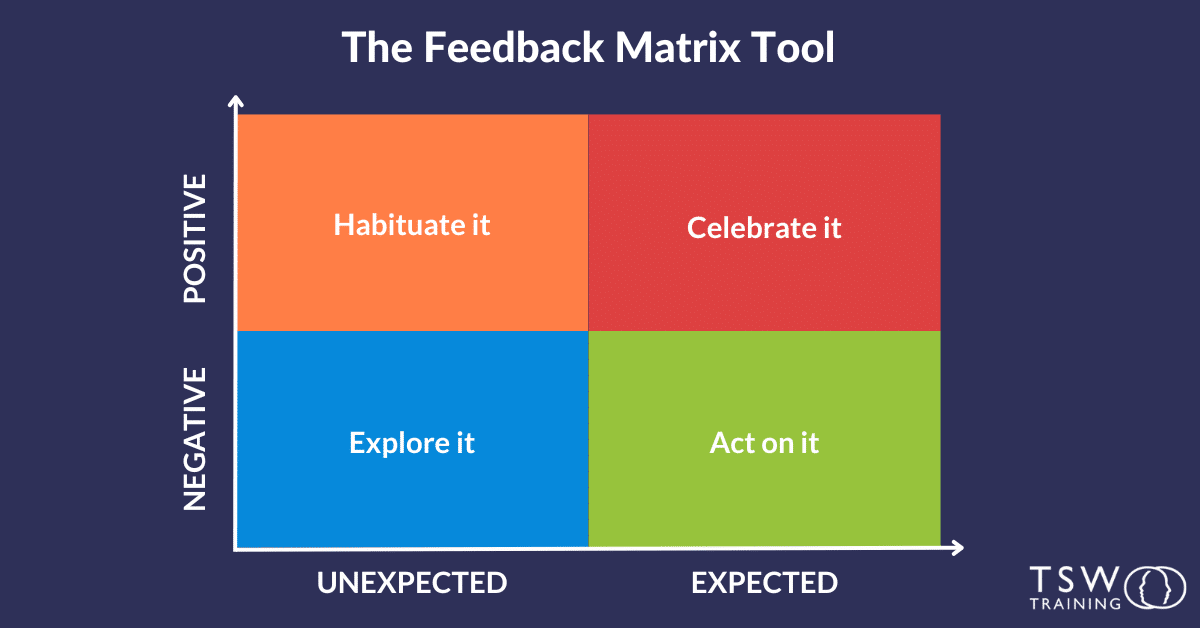The feedback matrix (also known as the feedback review matrix) is a simple yet useful tool which aids in providing structured and constructive feedback in various professional settings.
By organising feedback into a 2×2 grid of different categories and levels, the feedback matrix offers a systematic approach which promotes clarity and actionable insights. The tool can potentially assist people and organisations by enhancing communication, evaluating performance, and fostering continual improvement.
So how can the feedback review matrix be applied in the workplace? Here we’ll look at the concept, benefits and practical implementation of the feedback matrix tool.
⏰Key points:
- Feedback is allocated to four quadrants, with negative to positive on the y axis, and expectancy on the x axis. For products and services, it may be more useful to label the x axis as general and specific.
- If feedback is negative and unexpected, it should be explored. If it’s negative but expected, it should be acted upon. If feedback is positive and unexpected, it’s worth making a habit of. If it’s positive and expected, then celebrate it!
- By categorising feedback, the tool promotes clarity, and also balance. When used properly, it encourages constructive feedback, and can drive positive change
What is the feedback matrix tool?
The feedback matrix is a surprisingly simple yet effective tool. It provides a visual framework which categorises feedback based on two key axes:
- Negative to positive
- Unexpected to expected
It’s presented as a two-dimensional grid, with each quadrant representing a different type of feedback. The four quadrants typically include positive unexpected, positive expected, negative unexpected and negative expected feedback.
By addressing both strengths and areas for improvement, the tool ensures a comprehensive and balanced approach to feedback. And by conducting a thorough analysis, you might potentially identify blind-spots and outlying factors worth considering.
How do you use the feedback matrix tool?
First off, you need to assess all feedback, ensuring it’s valid. Then group it and place it on the grid according to category. These insights then become actionable. Let’s say this feedback applies to you:
- Positive, expected feedback. Celebrate it! Your accomplishments should be duly recognised, and you should keep up the good work.
- Negative, expected feedback. Act on it. In other words, make a change. In making an actionable plan for change, it’s a good idea to set SMART goals for yourself.
- Positive, unexpected feedback. Habituate it. In other words, if it’s not just a one-off, make a habit out of it. Incorporate it into your routine. You could be on the verge of fostering a new skill.
- Negative, unexpected feedback. Explore it. Examine this feedback in greater detail to get a full handle on it. Is this a blind spot for you? Is this view shared by others? What’s the potential impact? Once you fully understand this feedback, you can work on making a change – either in yourself or your working environment – to ensure it doesn’t happen again.
*Find out more about identifying and acting upon your workplace weaknesses.
What are the steps to using the feedback matrix tool?
Now let’s take a step back. In order to implement the feedback matrix effectively, there are certain steps worth following.
- First, the person giving feedback needs to familiarise themselves with the tool and its four quadrants. Let’s say that’s you. It’s important to understand the purpose and content of each quadrant, as this means you’ll provide feedback in a targeted and meaningful manner.
- Second, as the feedback provider, you should carefully evaluate the person or team being assessed, identifying relevant strengths and areas for improvement. This analysis will enable them to provide specific and relevant feedback.
- Third, during the feedback process, you should ensure a balanced approach by addressing both positive and negative aspects. This promotes a fair evaluation, plus it maintains a supportive environment.
- Fourth, you must communicate the feedback in a clear, respectful and constructive manner. Provide specific examples to illustrate your points. This’ll make it easier for the recipient to process and act on the feedback.
*Find out more about giving employees feedback to create positive change.
In addition, it’s good to encourage dialogue and engagement during the feedback process. This allows the recipient to seek clarification, and share their perspective. It’ll also ultimately allow them to collaborate on improvement strategies. In other words, encouraging active listening and open communication will foster a culture of positive, growth-orientated feedback.
Finally, it’s important to always follow up on the feedback provided. Regular check-ins and progress reviews will help track improvement, and address any challenges which may arise.
How else can the feedback matrix be applied?
The feedback matrix doesn’t only have to be used for gathering feedback for individuals or teams. You can also use it to evaluate products, services, or other aspects of the organisation – such as your website.
Depending on what you’re gathering feedback for, you might find it more useful to use the x axis for general and specific feedback, rather than expected or unexpected.
So if you’re evaluating your product, for instance, you might place positive general feedback in the top-left quadrant. Whereas if somebody brings a defect, bug or other negative feedback to your attention regarding something specific – such as a product feature – it would be placed in the bottom-right quadrant.
What are the benefits of the feedback matrix tool?
The feedback review matrix offers several benefits for individuals and teams, as well as the wider organisation.
For starters, by providing a structured framework for delivering feedback, it offers clarity. By categorising feedback into specific quadrants, both the giver and receiver can better understand the nature and focus of the feedback being provided.
Furthermore, by ensuring that both positive and negative aspects are addressed, this approach fosters fairness and balance. And this helps to create a more well-rounded evaluation of performance.
The tool also encourages constructive feedback, by guiding those providing feedback to be specific and actionable in their comments. This enables recipients to better understand the areas that require improvement, and take appropriate actions.
What are the limitations of the feedback matrix tool?
While undoubtedly helpful, there are a few limitations to the feedback matrix to bear in mind.
For one, it’s necessarily subjective. Because it relies on individual perceptions and opinions, there’s room for individuals interpreting feedback differently. This also means that important contextual information could be missed in its application.
Similarly, by focusing on the views of the feedback provider, other perspectives may be overlooked. For example, if the individual works in collaboration with other teams, they may have valuable insights or alternative views you might be missing.
The individual focus also means that feedback may be swayed by bias or personal agendas, which can undermine its fairness – ultimately making it less effective.
In all this, it’s important to remember that using tools such as the feedback matrix isn’t an exact science. When used properly, it’s a useful tool for bringing feedback into focus, but may not be applicable to all situations.
Is the feedback matrix tool useful for managers?
The feedback matrix is powerful in its simplicity. It’s easy to grasp, balanced and actionable. By focusing feedback into categories, it makes it easier to deliver, and for the recipient to digest. Ultimately, this structured approach promotes clarity and fairness.
By implementing this tool, managers are enabled to deliver constructive feedback, with the goal of encouraging growth and driving positive change.
*When using the feedback matrix as part of a long-term strategy of continual improvement, consider using it in conjunction with the ‘plan, do, check, act’ model.








